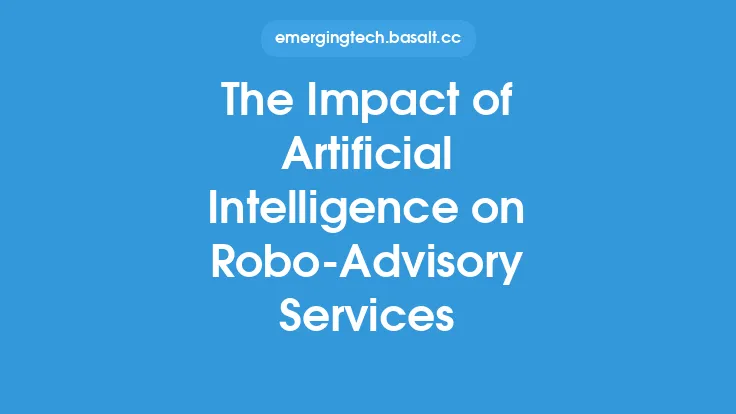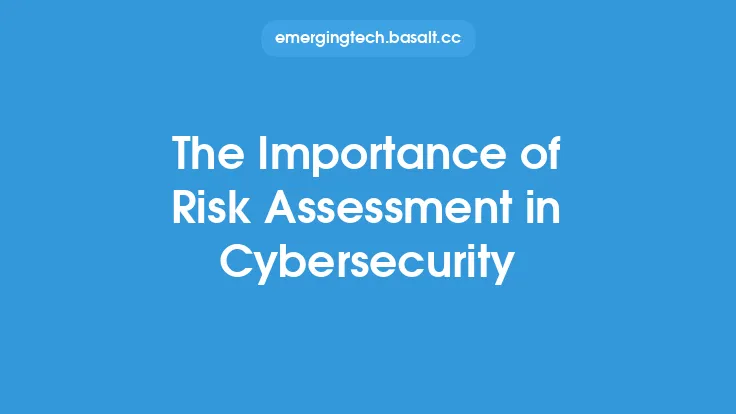The financial industry has witnessed a significant transformation with the emergence of robo-advisory services, which leverage technology to provide automated investment advice and portfolio management. As the demand for these services continues to grow, it is essential to emphasize the importance of risk management in robo-advisory. Effective risk management is crucial to ensuring the long-term success and sustainability of robo-advisory platforms, as it enables them to navigate complex market conditions, protect client assets, and maintain regulatory compliance.
Introduction to Risk Management in Robo-Advisory
Risk management is a critical component of robo-advisory services, as it involves identifying, assessing, and mitigating potential risks that can impact investment portfolios. Robo-advisors use advanced algorithms and machine learning techniques to analyze market data, detect potential risks, and adjust investment strategies accordingly. The primary objective of risk management in robo-advisory is to minimize losses and maximize returns, while ensuring that investment portfolios remain aligned with clients' risk tolerance and investment goals.
Types of Risks in Robo-Advisory
There are several types of risks that robo-advisors must manage, including market risk, credit risk, liquidity risk, operational risk, and regulatory risk. Market risk refers to the potential for losses due to fluctuations in market prices, while credit risk arises from the possibility of default by borrowers or counterparties. Liquidity risk occurs when assets cannot be sold or traded quickly enough to meet obligations, and operational risk is associated with the potential for errors, system failures, or other internal issues. Regulatory risk, on the other hand, arises from the possibility of non-compliance with relevant laws, regulations, and industry standards.
Risk Management Strategies in Robo-Advisory
To manage these risks, robo-advisors employ a range of strategies, including diversification, hedging, and asset allocation. Diversification involves spreading investments across different asset classes, sectors, and geographic regions to minimize exposure to any one particular market or sector. Hedging involves using derivatives or other financial instruments to reduce potential losses, while asset allocation involves dividing investments among different asset classes to optimize returns and minimize risk. Robo-advisors also use advanced risk modeling techniques, such as value-at-risk (VaR) and expected shortfall (ES), to quantify and manage potential risks.
The Role of Technology in Risk Management
Technology plays a critical role in risk management in robo-advisory, as it enables the development of sophisticated risk models, real-time monitoring of market conditions, and automated execution of risk management strategies. Advanced technologies, such as artificial intelligence (AI) and machine learning (ML), are used to analyze large datasets, identify patterns, and predict potential risks. Additionally, cloud computing and big data analytics enable robo-advisors to process vast amounts of data, simulate different scenarios, and optimize risk management strategies.
Regulatory Framework for Risk Management in Robo-Advisory
The regulatory framework for risk management in robo-advisory is evolving rapidly, with regulatory bodies such as the Securities and Exchange Commission (SEC) and the Financial Industry Regulatory Authority (FINRA) issuing guidelines and rules to ensure that robo-advisors manage risks effectively. The SEC's Regulation Best Interest (Reg BI), for example, requires robo-advisors to act in the best interests of their clients and to disclose potential conflicts of interest. Additionally, the SEC's Custody Rule requires robo-advisors to maintain custody of client assets in a separate account, to protect clients from potential losses.
Best Practices for Risk Management in Robo-Advisory
To ensure effective risk management, robo-advisors should follow best practices, such as maintaining a robust risk management framework, regularly reviewing and updating risk models, and providing transparent disclosure of potential risks to clients. Robo-advisors should also establish a culture of risk awareness, provide ongoing training to employees, and maintain a strong internal control environment. Furthermore, robo-advisors should engage with regulatory bodies, industry associations, and other stakeholders to stay informed about emerging risks and regulatory developments.
Conclusion
In conclusion, risk management is a critical component of robo-advisory services, as it enables robo-advisors to navigate complex market conditions, protect client assets, and maintain regulatory compliance. By understanding the types of risks, employing effective risk management strategies, and leveraging technology, robo-advisors can minimize losses and maximize returns, while ensuring that investment portfolios remain aligned with clients' risk tolerance and investment goals. As the robo-advisory industry continues to evolve, it is essential for robo-advisors to prioritize risk management, maintain a robust risk management framework, and follow best practices to ensure the long-term success and sustainability of their platforms.





